|
Voigtländer
Vito BL
My first
camera was a Voigtländer Vito BL, given to me by my late father, when I was
only 12 years old. He was a wonderful person who would at all times rather give than receive. Despite he passed away ten
years ago I still miss him.
It was on a
quite ordinary day in May 1957 and even if it is nearly 52 years ago I still remember
it very clearly. It was to be the beginning of a life time hobby.
Till that
day I had only taken two pictures. It was the summer before with my father's
probably pre-war Agfa camera, which could take eight pictures in 6 x 9 cm (2 ¼”
x 3 ½”) on a 120 roll film. It was in 1956 on a holiday in Germany and both pictures showed
the castle in Goslar (Harz), one with my father and mother in the foreground
but shaken; the other being sharper but the horizon skewed.
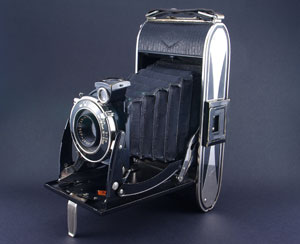
My father's type of camera, an Agfa Billy Record. The lens was an Agfa Anastigmat Jegstar 105mm/8.8. Other aperture settings: 11 and 16. Shutter speeds: B, 1/25, 1/50 and 1/100. Add to that slow films with 20 to 40 ISO. No wonder that films by that tine were often underexposed and unsharp.
The Voigtländer was a
24x36 mm camera with something quite extraordinary: a built-in exposure meter.
The distance, however, had to be set by eye - until I got another device: a
distance meter to put into the camera shoe. It had a finder and a wheel with a
distance scale identical to that on the lens.
The finder of the meter had an advantage over that of the camera: an extra layer showing the centre of the
motive in pink but displaced until you by turning of the wheel brought the pink
image to exactly overlay the original layer.
|
You would then look at the scale and set
that of the camera lens in the same position.
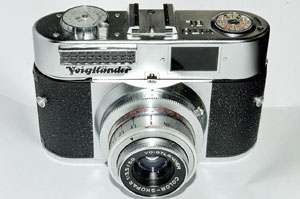
Voigtländer Vito BL with a f3.5 Color Skopar
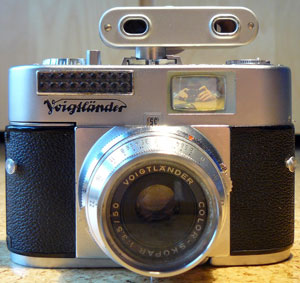
A Vito BL with distance meter mounted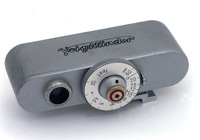
The Voigtländer distance meter
|
I would use the Vito BL primarily with Ferrania Color reversal films (slides). The Italian
film was no more than 13 DIN, equal to 16 ASA/ISO and available with only 20 exposures.
In 1958 it was re-launched, and now speed had gone up to 15 DIN or 25 ASA
and you could have films with 36 exposures.
|
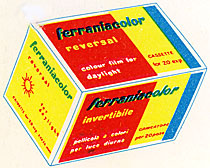
|
Voigtländer Vitessa T
For my communion in October 1958 I had a new camera, a Voigtländer Vitessa T as a gift
from my parents. It was a range finder camera with built-in exposure- and
distance meter.
Like almost all German cameras it had the rather questionable
Synchro-Compur leaf shutter.
The 50 mm standard Skopar 2.8 could be interchanged by a 35 mm wide angel lens
and two telephoto lenses, a 100 mm and a 135 mm. A special finder, but usable
with all of the four lenses, should then be mounted in the camera shoe.
One and a half years later I got the 135
mm Super-Dynaret f/4 for it.
I still
have the Vitessa. She shutter hasn’t functioned for 30 years. But apart from
that it is a beautifully made camera.
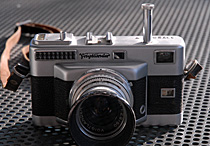
Voigtländer Vitessa T with 50mm/2.8. The high knob was for winding the film.

The Vitessa with the 135 mm/4.0 lens and the special finder mounted. It was a quite tiny lens. As comparison the 135mm/2.0 Nikkor AF DC lens is shown to the left.
|
Films were now Agfa UT 16 (East Germany), Agfa CT 18 (West Germany), Perutz C 18 (West Germany) and Gevacolor (Belgium).
Till this
day the Ferrania and Agfa slides have kept colours reasonably well, Perutz and especially
Gevacolor not.
|
|
Other equipment
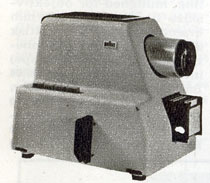
The slides were viewed with this Braun PA2 projector, one of the first to use magazines

The electronic flash had been invented but was very expensive. In stead I used throwaway flash bulbs. For daylight slide films they were blue, for black and white films white.
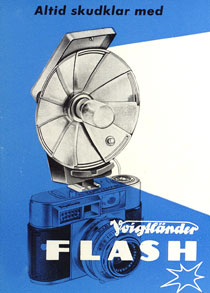
The Voigtländer flash for throwaway bulbs could be folded. Having taken a picture there would come a rather bad smelling smoke from the now almost melted and extremely hot bulb which could be ejected by means of a bottom on the back of the flash.
Five years ago I happened to find a Vito BL at a photo dealer's in Cologne, not exactly the same model, but 99% identical with my first camera. Probably a 1958 edition.
|